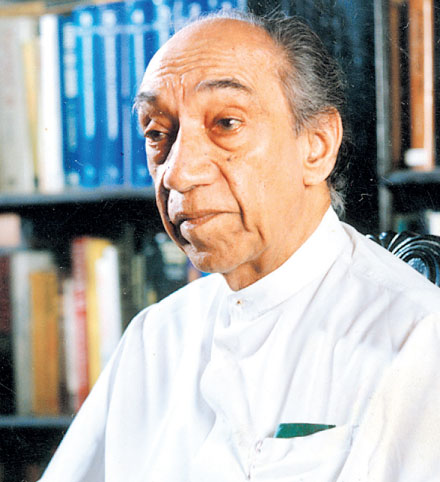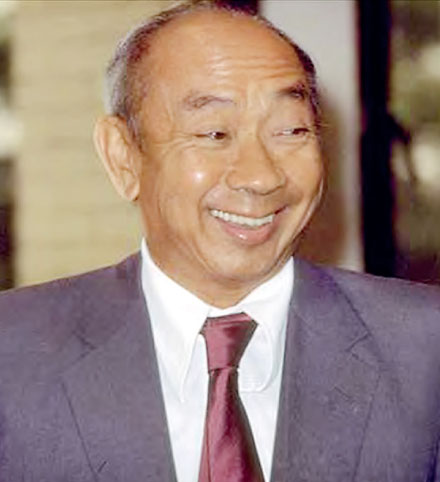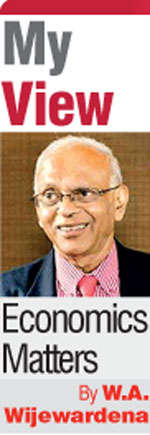Wednesday Nov 26, 2025
Wednesday Nov 26, 2025
Monday, 15 August 2022 00:30 - - {{hitsCtrl.values.hits}}

Former President late J.R. Jayewardene

Former Deputy Prime Minister of Singapore late Dr. Goh Keng Swee
|
 The ignored Shenoy Report
The ignored Shenoy Report
One of the qualities attributed to J.R. Jayewardene as a statesman was his willingness to seek advice from better informed experts. In 1966 when he was Deputy Prime Minister and Minister of State, he sought the advice of the Indian economist B.R. Shenoy as to how the crisis ridden Sri Lanka economy could be rescued. The Shenoy report in every respect was much ahead of the time and, had it been implemented, it would have provided an opportunity to make Sri Lanka another Singapore.
But according to his biographers, K.M. de Silva and Howard Wriggins, it was killed by the then Prime Minister Dudley Senanayake in fear that it was a ploy by JR to oust him from power as it had happened in 1953 when the subsidised ration of a measure of rice at 25 cents was abolished. I have written about the fate of the report elsewhere and it could be accessed at https://swarajyamag.com/economy/the-ignored-b-r-shenoy-report-of-1966.
The unimplemented Goh Keng Swee Report
There is another unknown report which had been prepared by Dr. Goh Keng Swee, Singapore’s first finance minister and later Deputy Prime Minister, at the request of JR after becoming President in 1978. The economic crisis which JR faced at that time was same as what his nephew, President Ranil Wickremesinghe, is facing today though it was on a lower scale. The 27-page report, dusting at the J.R. Jayewardene Centre in Colombo, was accessed by me recently. In view of the rigor and the depth of the analysis and advice presented, it is thought that a detailed analysis of same is in order today.
The bankrupted economy inherited by JR
When JR assumed presidency in 1978, Sri Lanka’s economy was in a dire state. There was a massive shortage of foreign exchange leading to 100% depreciation of the rupee. Unemployment rate was at high 27% of the labour force. National savings, despite the measures to increase them via curtailed consumption and compulsory savings, amounted on average to 11% in the five-year period prior to 1976, far short of the required investments of about 30% to keep the growth rate above 6%. Economic growth rate on average amounted to 3% during the same period, much lower than the historical average growth rate of 4.2%. Inflation had been suppressed through price controls, rationing of consumption, and inefficient public sector distribution, but it was still above 7% annually.
There was a black-market practically for every good, from consumption goods to investment goods to foreign currencies. The exchange rate was on a multiple currency system with a fixed exchange rate and another with a premium of 65% in the foreign exchange entitlement certificates. Since all imports, except those of the government, had been subject to these certificates, it was a major revenue source for the government. As a result, the government revenue as a share of GDP had been maintained at about 22%. This had brought in the beneficial result of generating a surplus in the revenue account – known as government savings – for most of the period. However, the budget was in deficit at about 6% of GDP on average.
Meanwhile, broad money stock increased by 85% from 1971 to 1976. Given the real growth of 15% over this period, this showed that there was an excessive growth in the money stock creating considerable inflationary pressures in the economy. That pressure had been suppressed via artificial means that had led to long queues or waiting lists for every consumption or investment item. It was, therefore, clear that there will be uncontrollable open inflation and consequential exchange rate depreciation once the ineffective economic controls are removed. These imbalances in the macroeconomy-high aggregate demand against very low real growth-had been looming over JR just as they have been looming over his nephew who has ascended to presidency by a vote in Parliament today.
Seeking Goh’s advice
According to JR’s biographers, the reason for commissioning Goh to write this report was that he had been advised by all that he should seek IMF and World Bank support for economic reconstruction, and, though he had been convinced of the need for pursuing that path, he wanted to get a second opinion on the issue. In my view, this was a good choice because Singapore had mapped out its development strategy without the support of either of these institutions. Hence, the opinion of an expert who had been successful without jumping onto the IMF-WB bandwagon would have been the appropriate choice because there was no pre-bias for IMF-WB programs. But it should be pertinent to note that though Singapore did not seek their financial support, its monetary, fiscal, exchange rate, interest rate and growth policies were in line with what these two institutions would normally recommend to a member who seeks their support.
Problems in the economy
Unfortunately for Sri Lanka, like the previous Shenoy report, Goh’s recommendations were not implemented by the JR administration to the detriment of the country’s economy for many more years to follow.
Goh starts his report by noting that by the time JR became President, Sri Lanka which was a potentially rich country had been driven to the verge of bankruptcy due to the wrong policies adopted by the previous Sirimavo Bandaranaike administration. Hence, the policies to be adopted to reverse the situation should necessarily be bitter and painful. Yet the government had courageously implemented the necessary initial reforms in the form of opening the economy, unifying the exchange rate, dismantling costly controls, and removing the subsidies. As a result, there had been a robust economic expansion in the first two years of his presidency, namely in 1978 and 1979. But after this expansion, there had been a number of problems which the administration had faced.
Preemption of resources by the government
The first issue had been the preemption of resources by the state sector to the detriment of the private sector. This has been explained by Goh as follows: “Out of an estimated sum of Rs. 18,340 million expected to be spent in 1980 as total investments, the government’s share was no less than Rs. 9,380 million. Of the balance, the greater portion represented investments by public corporations, so that investment in 1980 in the private sector is expected to amount to about 15%.
“This is an exceptionally small potion in a free enterprise system. In Singapore, private sector investments in 1979 comprised no less than 75% of the total, despite large government expenditure on housing and the new International Airport at Changi” (p 3). This has largely been facilitated by the inflow of concessionary funding from overseas and the government’s ability to tap domestic resources from captive sources, namely, EPF, NSB, and Insurance Corporation. But it portended the future growth to be curtailed due to the low investment by the private sector.
Sharp increase in prices
The second issue pertained to the sharp increase in the prices of construction materials due to the government’s heavy infrastructure development programs. During 1979 through 1980, the price of steel bars had almost doubled, while all other major items like cement, bricks, and roofing materials had increased between 150% and 346%. This had been compounded by a shortage of skilled construction workers who had sought greener pastures overseas. As a result, large construction projects contracted to foreign contractors had to depend on migrant workers.
Goh had advised JR that in the long run this would have been automatically resolved by an increase in the supply. But in the immediate run, it would certainly impose additional costs on those contractors. Since it would have a negative impact of both growth and GDP, Goh’s recommendation was very clear. He advised that “the public investment program be substantially curtailed” and the announced across board cut in the expenditure by the Minister of Finance by 25% in 1979 should be implemented in practice. At the same time, no ministry should be allowed to apply for supplementary appropriations to meet increased costs in the financial year.
He further cautioned JR that curtailments should be made in the case of local rupee funded projects and not in the case foreign aid funded projects. This was considered an appropriate recommendation because it would help the government to keep the budget within limits and ensure an uninterrupted inflow of foreign exchange to the country that had a massive savings-investment gap needing to be filled by using foreign savings.
Inflation: Public enemy number one
This recommendation shows that Goh was particularly concerned about the rising inflationary pressures in the economy. This is understandable because when the economy was open, the aggregate demand was increased through increased government expenditure by resorting to both domestic and foreign financing. But in a state of constrained supply, it is the general price level that gives way. In a growing economy, inflation is the public enemy number one and it need be defeated at any cost.
Goh had specifically given the following advice to JR about the threat of inflation: “These reductions will be unpleasant medicine. But it is overdue and the consequences of avoiding them will be extremely damaging as I shall explain later. If they are enforced with a high degree of fiscal and monetary discipline from now to the end of 1981, with good fortune, inflation will be brought under control and reduced to 10-12 percent by then. If you run into bad luck, such as another major increase in the price of oil or a fall in the price of your export crops, or if there is some slippage in discipline and in the austerity program, inflation could continue to mid 1982 or beyond” (p 10).
He had further said that once “inflationary pressures are brought under control, you will be able to expand the economy in a long-term non-inflationary growth process. The sooner this is achieved, the better are the prospects that by the general election of July 1983, you will succeed in getting the economy in a healthy buoyant state” (p 11).
|
JR’s failure to control inflation
However, the inflationary situation slipped out of JR’s hands because he was not able to prune the capital expenditure program as recommended by Goh. Inflation which amounted to 11% in 1979 shot up to a historically high level of 26% in 1980 but due to extremely restrictive monetary policy measures adopted by the Central Bank, it began to decelerate since then. In 1981, it fell to 18% and gradually decelerated to 1.5% by 1985. The failure to plan the macroeconomic stability properly right from the beginning resulted in inflationary pressures building up in the economy, on one side, and pressure for the exchange rate to depreciate, on the other.
The restrictive monetary policies punished the victim – private sector – and not the culprit –the government. The result was the deceleration of the growth rate from the high 8% initially to a level of 5% on average in the next five-year period. Over years, Sri Lanka’s norm growth was 4%, a little less than this 5% growth.
Use of bank-created money
Goh has warned against the use of bank-created money for financing the investment expenditure of the country. This is in line with the categorisation of savings into real savings and bank-created savings (available at: https://indiapolicy.org/debate/Notes/shenoy.PDF). Real savings are those generated by people by curtailing consumption. They are called real savings because they help people to consume or use as an input for further production. It is these real savings that should be invested for generating growth. In contrast, there are bank-created savings, called imaginary savings or involuntary savings, initially done by the central bank by printing money and later by commercial banks by using it for multiple deposit and credit creation.
According to Shenoy, these savings do not generate long-term economic prosperity but inflation. Goh has confirmed this as follows: “If such expenditure is not financed out of real savings but through central bank credit creation, this will cause a general rise in the price of consumer goods, and it is the familiar spectacle of too much money chasing too few goods. That this has happened recently is borne out by the increase in the consumer price Index and the volume of Treasury bills issued. In the last twelve months, the Colombo Consumer Price Index has increased by 24%. The World Bank believes that this understates the rate of inflation which they set at 33%. It is beyond doubt that the principal cause of this has been to the failure to balance expenses with revenue plus borrowings of real savings. Deficits were financed out the issues of Treasury bills nearly all of which were bought by the Central Bank. This method of financing has high inflationary consequences.”
|
Unchecked borrowing from the Central Bank
But this warning was not heeded to, and JR administration used Treasury bills to borrow from the Central Bank in increasing amounts to finance the high budget deficits. To facilitate this, the Treasury bill limit was raised from Rs. 3 billion in January 1980 to Rs. 10 billion by December. Goh had advised that the government should generate real resources by increasing taxes and not by printing money. He had said that unless this process is immediately stopped, Sri Lanka running into galloping inflation was a near certainty. In fact, it became a certainty in the subsequent years.
Evil of money printing
Money printing and financing budget deficits are an evil because they lead to uncontrollable inflation. But it has other implications which cannot be seen immediately. Goh has said that people with the new money in their hands will buy imported goods creating balance of payments difficulties. To avoid this, he had said that exports and capital inflows should be increased. Otherwise, the depleting foreign exchange reserves will force the exchange rate to depreciate.
He had warned JR: “Unless the process is stopped and reversed, the country can find itself caught in the vicious spiral of increasing domestic money stocks, increasing demand for imports, depreciating exchange rates, higher rupee cost of imports and greater demand for Central Bank credit creation.” However, the Central Bank credit creation has been used liberally by all successive governments because that was the easiest path available to a government that does not want to raise real funds through taxation. This was specifically true during Gotabaya administration, and it is happening in large volumes in the Ranil Wickremesinghe administration too.
Need for cutting expenditure
Because of these issues, Goh had advised JR to cut expenditure logically without reducing growth and employment and not to use bank money to finance the deficits. His concluding remark said it all: “Mr. President, it is a matter of personal regret that my report will bring no joy to you, your ministerial colleagues, and your countrymen. But I cannot see any other way out to retrieve the position.”
Consequences of not heeding to Goh
But this sound advice was not followed, and the result was continuous inflation, depreciation of the exchange rate, building of the depleted foreign reserves by borrowing, increase in foreign and domestic debt, and slow economic growth. Sound economic advice is not palatable to politicians who love to talk about long-term planning but act to maintain their power base in the very short-term. When the politicians act in this manner, those who are around them too fear telling them the truth. Perhaps, Goh would have noticed it during his brief stay in Colombo. That may be the reason for him to conclude his report with this piece of advice which is eternally valid: “May I make a final suggestion? The weekly briefing team whom you sent to meet me should be encouraged to tell you the unpleasant truth and should not try to conceal the gravity of the situation.”
In my view, those involved in the Ranil Wickremesinghe administration should compulsorily read the unused Goh Keng Swee Report until such time they are familiar with every word which Goh has said and the disastrous consequences that follow if they are not heeded to.
(The writer, a former Deputy Governor of the Central Bank of Sri Lanka, can be reached at [email protected].)